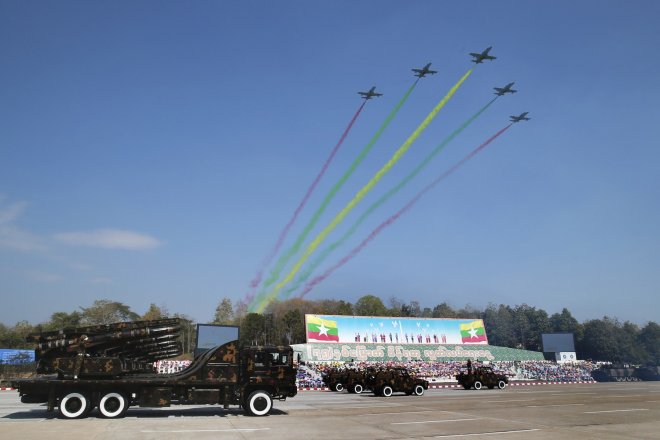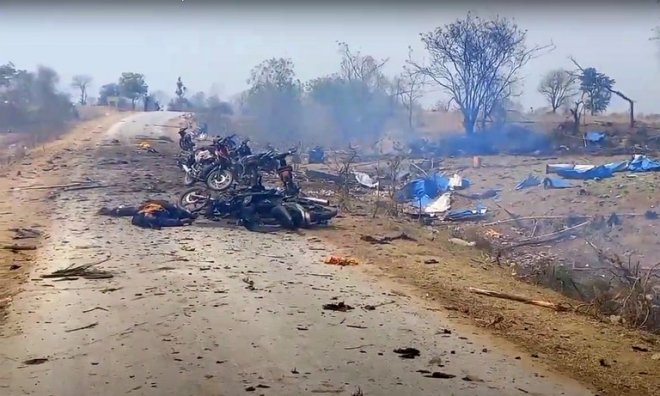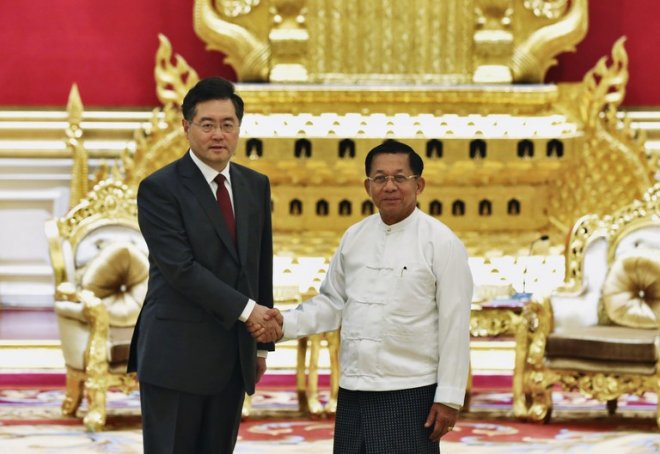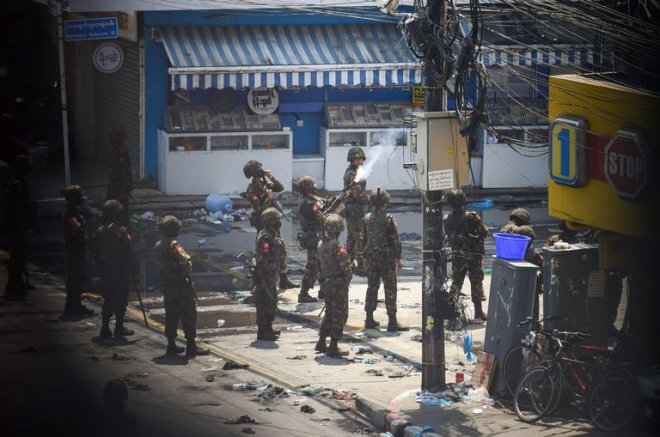
Chinese and Russian entities have sent more than US$660 million in weaponry and other arms-related equipment to Myanmar’s military since its coup two years ago, enabling the junta to wage its brutal campaign to retain power.
The sales are part of US$1 billion in total in arms-related trade to the country since the Feb. 1, 2021, coup, “despite overwhelming evidence of the Myanmar military’s atrocity crimes against the people of Myanmar,” United Nations Special Rapporteur for Myanmar Tom Andrews said in a statement Wednesday.
The support comes in a variety of ways, including advanced weapons systems, spare parts for fighter jets, raw materials and manufacturing equipment for domestic weapons production. Perhaps most critical to the military’s insurgency suppression efforts is the supply of aircraft that it has used to strike combatants and terrorize citizens who live in areas of resistance.
The report identified US$406 million in arms sales from 28 Russian entities and US$267 million from 41 state-owned and private companies in China.
“Given the widespread reporting of the Myanmar military’s war crimes, China has arguably made these transfers with actual knowledge that the Myanmar military will use the fighter jets transferred by its state-owned arms manufacturers in attacks on civilians in violation of international humanitarian law,” the report states.
Sanctions ineffective
Sanctions imposed by the United States, members of the European Union and other countries have been ineffective in stopping the flow of weaponry into Myanmar, Andrews said.
“Those providing these weapons are able to avoid sanctions by using front companies and creating new ones while counting on lax enforcement,” Andrews said.
The report urges new efforts, including sanctions on one of the military’s main sources of revenue, the Myanma Oil and Gas Enterprise. So far, the European Union is the only entity to sanction the company.
 The aftermath of the Myanmar junta’s shelling and airstrikes on Pa Zi Gyi village, Kanbalu township, Sagaing region on April 11, 2023, that killed nearly 200 civilians. Credit: Citizen Journalist
The aftermath of the Myanmar junta’s shelling and airstrikes on Pa Zi Gyi village, Kanbalu township, Sagaing region on April 11, 2023, that killed nearly 200 civilians. Credit: Citizen Journalist
Declaration of friendship
After earlier indicating some impatience with the Myanmar military regime led by Senior Gen. Min Aung Hlaing, Chinese officials appeared to reaffirm support earlier this month.
Chinese Foreign Minister Qin Gan hailed the “friendship” between the two countries during a meeting with the junta leader on May 3, according to official reports.
An email to the Chinese Embassy in Washington was not returned.
Myanmar military’s relationship with its more powerful neighbor has been among the keys in its ability to hold onto some semblance of power despite widespread opposition among an array of armed groups, including ethnic-armed organizations and militia forces.
 Myanmar junta leader Min Aung Hlaing, right, shakes hands with Chinese Foreign Minister Qin Gang during their meeting in Naypyitaw, May 2, 2023. Credit: Myo Kyaw Soe/Xinhua via AP
Myanmar junta leader Min Aung Hlaing, right, shakes hands with Chinese Foreign Minister Qin Gang during their meeting in Naypyitaw, May 2, 2023. Credit: Myo Kyaw Soe/Xinhua via AP
“The Myanmar military’s relationships to Russian and Chinese arms suppliers are the backbone of the junta’s combat capabilities, without which its ability to hold on to the country’s center and urban areas would likely suffer substantially,” said Lucas Myers, a senior associate for Southeast Asia at the Wilson Center, a Washington, D.C.-based think tank.
The report says that Chinese K-8 fighters had been the most frequently spotted ground attack jet of the Myanmar Air Force before April 2022, when the Russian Yak-130 began to be deployed more often.
In December, China shipped six FTC-2000G fighters, which combine training and attack capabilities, to Myanmar. The delivery is “concerning,” Myers said.
Support from Singapore, Thailand
The arms have been used in a number of documented atrocities committed by Myanmar’s military, including a Sept. 16, 2022, hour-long attack on a school and monastery in Let Yet Kone Village led by Russian Mi-17 and Mi-35 helicopters. At least six children were killed in the attack.
Andrews’ report also notes the not-insignificant amount of sales from Singapore, India and Thailand, which collectively come to US$333 million in arms trade.
“Arms dealers operating out of Singapore are critical to the continued operation of the Myanmar military’s deadly weapons factories (commonly referred to as KaPaSa),” the report states.
Andrews noted the Singapore government’s declaration to block any arms transfers to Myanmar.
 Myanmar army officers intervene during a protest against the military coup in Yangon, March 2, 2021. Credit: Reuters
Myanmar army officers intervene during a protest against the military coup in Yangon, March 2, 2021. Credit: Reuters
Zachary Abuza, a professor at National War College in Washington and an expert on Southeast Asia, said that Thailand’s and Singapore’s sales to Myanmar, though smaller than either Russia’s or China’s, are important because the goods they ship allow the military to continue to produce its own munitions.
With a floundering post-coup economy, the junta doesn’t “have a lot of money for imports,” making its domestic manufacturing capability “critically important” to its efforts to hold onto power, Abuza said.
Singapore and Thailand may also be more responsive to U.S. pressure to stem the flow of imports into Myanmar, compared with either Russia or China, he said.
Since the coup, the military has killed at least 3,500 civilians, detained at least 22,000 political prisoners and forcibly displaced over 1.5 million people, the report states, citing figures from the Assistance Association for Political Prisoners, a human rights group based in Thailand.
Edited by Malcolm Foster.
